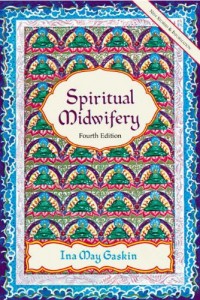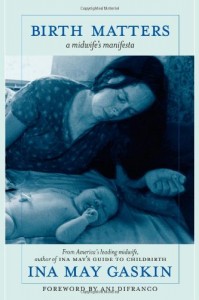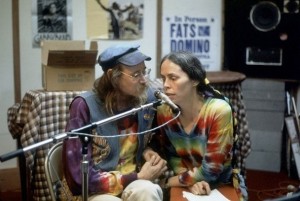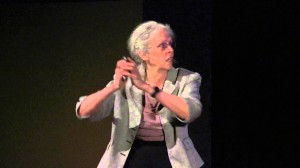An Interview With Ina May Gaskin, Godmother Of Modern Midwifery

Photo above: L to R, Karen Brody, Stephen Gaskin, Ina May Gaskin, Lisa Reagan. Lisa caught up with Ina May in Washington, DC, in July 2011 for her appearance on the The Diane Rehm Show, see photo to left. Ina May spoke to the 2.2 million radio show listeners about her new book, Birth Matters: A Midwife’s Manifesta.
Watch Lisa’s interview with Ina May about her book below and here. Watch the bonus discussion between playwright Karen Brody and Ina May about birth, the play and the movement, here.
Download and Listen to Kindred’s Interview with Ina May Gaskin
Ina May Gaskin: The Godmother of Modern Midwifery
An Interview

In the midst of the baby boom’s promises of Twilight Sleep to conceal the routine use of episiotomies, forceps and brute force in overflowing maternity wards, Ina May Gaskin found herself surrendering to a traumatic medical birth and being separated from her infant, whom she “doubted was mine when they brought her to me.” She, like many women of her era, began to question what was going on behind the hospital screen and fear-based medical propaganda. This collective questioning, chronicled in proper public spaces like The Ladies’ Home Journal, grew into a national natural birth movement whose mission was to find and share the truth about birth and its promise of empowerment and connection, instead of trauma and separation.
In 1970, inspired by women’s stories of homebirth, Ina May decided to become a midwife and started delivering babies while on a historic cross-country “caravan” with her visionary husband, Stephen, and 300 self-described “hippies” who founded the back-to-nature community known as The Farm in Tennessee. With other midwives on The Farm, Ina May opened one of the first birthing centers in the country. Since then, more than 3,000 women have given birth there, and the C-section rates are an astonishing 2 percent, while the national average hovers at 32 percent and countries like Brazil are at 95 percent. (The World Health Organization recommends a C-section rate of less than 15 percent.)
In 1975, Ina May published Spiritual Midwifery to share her insights into “normal” birth processes, a now-seminal work credited with saving the midwifery profession from the century-long attack of the founding fathers of obstetrics. Her latest book, Birth Matters: A Midwife’s Manifesta (Seven Stories, April 2011), details the history of birth in America, and other countries, as a route to understanding how the shockingly high rates of maternal and infant mortality in the medical model came to be, despite equally skyrocketing maternity care costs; why America fell into a backward trend with regard to birthing (the U.S. ranks behind 28 other countries); and why the Midwives Model of Care is the wellness paradigm for empowering, healthy births. In Birth Matters, Ina May calls for the right to birth without medical intervention, as facilitated by midwives inside the wellness paradigm, to be formally recognized as a human right.
Lisa: What stage of labor is the natural birth movement in the U.S. right now?
Ina May: Oh, well, we’re still dilating! We’re nowhere near ready to push!
Lisa: The Centers for Disease Control (CDC) said in May 2011 that homebirths in the United States are up 20 percent. Is this good news?

Ina May: It sounds impressive, doesn’t it? But really that puts us at about 1 percent, which is where we were in 1989 before the dip of the 1990s, so now we’ve recovered the dip. So, 1 percent, yeah!
Lisa: On the heels of the CDC announcement, the United Nations released the results of its first systemic survey and Global Midwifery Report since 1976—one year after Spiritual Midwifery was published. The U.N. report declares a global investment in midwifery would save millions of mothers’ and babies’ lives. In the U.S., the trend is toward hospitals shutting down midwives and birth centers. It appears the rest of the world has a different view of midwifery than the United States?
Ina May: The United States took a unique turn from where the rest of the world went in the early 20th century, when the fathers of obstetrics decided to wipe the profession of midwifery off the map. They were successful in doing it; it only took about 20 to 30 years to make it illegal in some states and disreputable with a big propaganda campaign. They depicted midwives as ignorant, unfashionable, dirty old women that might serve you rat pie when they came to take care of you. That was an actual phrase that was used. And they lied and said the European countries were following the same course, which they decidedly were not. So we live with the history of the early 20th century, when birth first started moving into hospitals.
Lisa: What was the impact of this transition of moving away from a woman- and child-centered midwifery model of care toward birth in hospitals?
Ina May: This is when medical students started getting training in hospital wards in large numbers. While in Europe there was a move to hospital births, the midwives still attended the births there. That made for a very different experience for those student doctors in European countries, who were not as apt to pick up forceps— or scissors for an episiotomy—because the midwives (who knew what a normal birth looked like) would say no, and advocate for the woman to birth without interference. European women, who are aghast at our medical births, have asked me since the 80s why American women would allow themselves to be cut, especially because they thought American women were strong. I told them U.S. women didn’t know it was being done to them, and you just found out about it afterward when the anesthesia wore off.
When you replace midwives with obstetric nurses, who are not prepared or trained by midwives, they saw brutal births—pushing and pulling and routine episiotomies and lots of blood. They were not permitted to let the baby be born if the doctor wasn’t there, so they did a lot of preventing birth by holding women’s legs together. So we developed a culture of some pretty brutal practices that were taken for granted as the best that could be done for women, and women themselves had to accept this because they had no other reality.

Lisa: In your new book, Birth Matters: A Midwife’s Manifesta, you write about the letter to the editor of The Ladies’ Home Journal in 1958 that an obstetrics nurse sent in anonymously, out of fear of reprimand, confessing “this is what I have seen, and it is brutal.” The magazine was then flooded with letters saying, “yes, this happened to me and it was horrible.” This obstetric nurse’s whistle-blowing seems to be a key moment in the vitalization of the natural birth movement.
Ina May: That definitely fed the movement. There were also lecture tours by Grantly Dick-Read, the author of the classic Childbirth Without Fear; that and probably some university professor’s wives went to Europe and found out about Lamaze and midwives, and there started to be a little bit of awareness that birth could be something different. So it began to be known among a mostly educated group of white women. The Ladies’ Home Journal found itself in the middle of this controversy and kept on printing these letters because they poured in from all over the country. This was in the middle of the baby boom, when maternity wards were bursting around the country and women were giving birth on gurneys in hallways. So, it seemed like a good idea to have midwives around again, but when the first nurse midwives from the American College of Nurse Midwives graduated they became a part of the teaching corps, and it was rare for them to attend births or for women to have a midwife-attended birth.
Lisa: You clear up a lot of mythologies around the history of birth in this manifesta, one of them being the cultural stereotype of homebirth and midwifery being a part of the feminist movement. In fact, because the feminist movement was conceived inside of the industrial paradigm and not a holistic paradigm, feminists advocated for the medical model of birth.
Ina May: Yes, there was a huge push to get women into hospitals and to make birth really “scientific.” The reasons doctors wanted to do this at the time was because they knew practically nothing about birth. They weren’t able to know about birth when birth happened in the home or when the women were the boss. We know this from the 19th century textbooks that said to the student doctor—and many of them learned just from textbooks that anyone could buy from a catalogue—not to go into the birth room until the women call you because your presence there could stop the labor for hours or days. So, if you want to accomplish this birth, get your money and go home; you are best to stay out of the bedroom until the women call you in, and that will be at the last minute. So doctors even then did not get to see births, and because the woman was surrounded by her friends and family, the doctor was not going to be allowed to pick up a pair of scissors. A survey in 1910 showed that doctors did not know about births and wouldn’t know unless they could herd women into hospitals—and banish the midwife—so that laboring women could be teaching material for them.
Lisa: And as you write in Birth Matters, what medical students learned was, Here is what labor looks like: woman is strapped down, woman is knocked out, woman is cut, baby is pulled out. And this became the norm?

Ina May: That’s right. And there are photos of these hospital births, where the women look like torture victims, but I did not want to put them in the book because I did not want young women to see them and think of birth this way. One photo shows a close-up of a doctor’s hand in a woman’s anus to help push the baby’s head out. They show fundal pressure, a strong man pushing very hard, and the blood is so horrific it is a wonder these women survived. This is scary, when this is presented as normal instead of malpractice. I hasten to say, farm boys were better at birth back then, because they knew every animal needs quiet and respect for her to do her job most effectively and less painfully.
Lisa: You talk in your book about women not knowing birth could be different as an obstacle of a cultural paradigm, which is a big idea for anyone to get their mind around. But here at Kindred, we talk about the wellness paradigm versus the cultural industrial paradigm all the time, and how we have to train ourselves to make informed choices and find holistic practitioners. Considering the context of the culture when you began to study birth as a lay midwife, your greatest achievement was to attend and document “normal” births and then to share your insights in Spiritual Midwifery in 1975. It seems like the term “paradigm shifting” doesn’t begin to describe your work!
Ina May: Well, thank you for recognizing that, because I think a lot of people didn’t. They would just say, oh those mad hippies doing this irresponsible thing. I would have considered it irresponsible to go back into the hospital and endure such treatment again. I knew it was crazy. I knew the doctor didn’t need forceps in 1966 when I was giving birth to my first child. I knew he was wrong and that couldn’t be right. But I thought, how can I argue with a doctor? He’s probably seen 1,000 births. It didn’t occur to me to say, “Okay, you’re dismissed. I’ll get someone else,” because I didn’t think there would be doctors who would disagree with each other, because I thought it was a scientific area of work. (Laughs)
I did get to experience an unmedicated labor before they came at me with the drugs, and got to experience a deep trance. I’d never been in a trance before, and loved it. I would not have described it that way, because when you are in a trance you are not thinking in words because you are experiencing. In my case, it was a colorful vision on a blank white wall to everybody else. It was beautiful and I was pretending to be an animal. Nobody told me to do that, it just occurred to me and it seemed to work. The only negative thing was the nausea from having been starved and not allowed to drink. My obstetrician had put me on diuretics during the pregnancy to keep my weight down. I just remember the scolding. So, this really wrong-headed doctor taught me by example how you should not treat anyone.
When I finally saw my daughter, when she was a day old, I had doubts that she was really even my daughter. After this experience, I began to talk to other people who had decided to have homebirths. Because these women’s empowerment was so obvious in their whole being as they told their stories, I knew that was what I was going to do. After that I had three births the way they should be, and decided to become a midwife!

Lisa: You wrote Spiritual Midwifery in 1975, and it is regarded as the book that not only saved midwifery, but put midwifery and natural birth back into the minds of Americans as a possibility. But looking back, it seems that this seminal work appeared just as medical technology began to take off, inspiring our high C-section rates today. I’m wondering if you ever felt like Cassandra, saying “Beware of Greeks,” and then the Trojan War breaks out?
Ina May: It’s a little like that. Things were so wide-open in the 70s; there was such fervor and a strong feeling across the country that we needed to get back to our natural ways. Lots of communities [like The Farm] were formed during that period. There were childbirth classes taking off, and a lot of reaction to The Ladies’ Home Journal letter, but obstetricians were taken aback by people coming in and wanting unmedicated births. And when I wrote Spiritual Midwifery, I had been in a hospital maybe three times, because women who birthed on The Farm rarely needed to go, so I was slow to know about epidurals and electronic fetal monitoring. These things almost sneaked up on me and were well-developed before I realized they were there. I started out in the 70s, when the C-section rate was only 5 percent, and I didn’t know anybody who’d had one.
In 1980, I learned that C-sections were now 20 percent. I thought, That’s huge! But I think what happened is that you had women saying they wanted unmedicated births, but when they went into the hospital, they were put flat on their backs to birth. Then, hospitals were terrified women were going to have homebirths, so they started hiring nurse midwives and saying they had “birthing” rooms. So they would adopt some of the language of the counterculture movement and slap it on the hospital room.
I think it worked to help people think things were nicer, but there was a backlash that built up, because people who went to a hospital had no idea that the kind of birth we were talking about depended upon your freedom to move. Because I did not know about these things, I was not able to express them in Spiritual Midwifery. So I wrote a book for people who were frightened of birth (Ina May’s Guide to Childbirth) and believed that birth must have been designed by a malevolent deity and anything men created to deal with it must be better. This book came out of my evolution of studying how things developed in hospitals.

Lisa: Is there such a thing as an ideal birth?
Ina May: Yes: in a place where you are most comfortable. If you have a woman who is terrified of being at home, the birth ought to happen in a hospital. There, her needs for privacy and low lighting would be recognized. Her need to be nourished through her labor met. I’d like to see, in my dream world, that everybody would have a midwife, like the law in Germany that says there must be a midwife at every birth. Hopefully, these midwives would get to know you prenatally, so they know you well and you trust each other. Since a midwife has to have a life, too, there would be two women you would work with in case one has a toothache. I think it is good when midwives work in groups, small groups. Someone might also have a longer labor and wear out one midwife and need to have the other one spell her.
We help the mother physiologically through the labor. Any fears she has are addressed and eliminated, which is possible for skilled midwives to do. We let the woman’s body do things the way it does best. We don’t have a rigid protocol that governs how long women are permitted to labor. It doesn’t make sense to have this stuff all decided on paper from the beginning because some women dilate quickly and some slowly, so we are mindful of vital signs, not the clock. All women are different, so there are no cookie-cutter, rigid guidelines. Ideally, the woman gives birth under her own power, and is able to move freely in labor and adopt the position that works best for her. And then, we don’t whisk the baby away—we leave the cord intact and place the baby on the mother, who is the ideal warmer, and place them chest to chest, so the baby can drain any fluids with ease. We postpone all this weighing and measuring stuff, as the baby is not going to get taller. We recognize that the time right after birth is very important, not just for the mother and baby to bond, but because this time together is capable of preventing hemorrhages, with the least blood loss. It also helps the placenta to come. The mother and baby are left together, and the partner is able to feel a part of this experience.
It is an amazing transformation that can take place in people when they find out the strength of birth and what an amazing source of information and inspiration it can be. It affects your life forevermore. How great it is to pull strength out of birth, rather than be the passive victim in a ritual of separation, which is too often what we see in the hospital—that people actually get driven apart by birth. When you look into the mammal world, birth is all about connection, and without all of that intervention, mothers and babies naturally connect and don’t have to be put back together again. We tell ourselves that we don’t have any instinct to birth, but we do this because we have all of this interference that makes it impossible to know what our inner impulses are when there are so many orders, procedures and things happening to us during the time when we should be allowed to flow with this amazing energy.
I keep being amazed by the number of birth books that don’t even mention “energy” and the energy of birth. When I witnessed my first birth, on a school bus, the woman’s level of energy was, well, I’ll use the phrase a Japanese obstetrician uses—“mystic beauty”—when he sees a woman in her full power. That is what I saw in my first birth. We miss that when the woman in labor is not given the amount of respect she needs in order to accomplish this work she is doing.
Lisa: In Birth Matters, you point out that women are more afraid of normal birth than major surgery, hence the climbing C-section rates. You suggest that women and men counter this fear by learning what a normal birth is, by reading birth stories or by attending a normal birth. What other ways can we advocate for the human right of an intervention-free birth?
Ina May: This book, Birth Matters, was written because a twentysomething-year-old woman at a publishing house asked me to help her explain to her family why she wanted to become a midwife. She wanted to show her family why becoming a midwife was a better idea than becoming an obstetrician. So I answered her questions, which were many, and ended up writing a manifesta! She is at midwifery training right now [this interview took place in June 2011]. The book answers all of our questions on why birth in America is the way it is, and how we can move out of the medical model and to a woman/child-centered model. As I end in the book, woman-centered care is a human right, but we don’t have enough midwives to meet demand, especially in the U.S. As the U.N. declaration states, we need more midwives.
This interview first appeared in Pathways to Family Wellness’ Fall 2011 issue.

